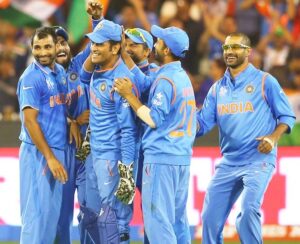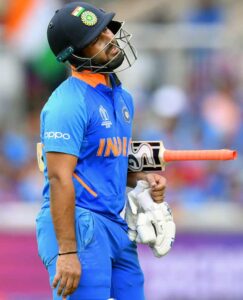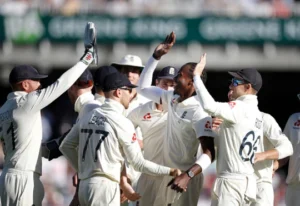Master at the Grand Stage Unraveling the straits of Team India in the WTC Final
The loss in the ICC World Test Championship (WTC) Final between India and New Zealand has left Cricket players around the world disappointed.
Despite being the top- ranked Test side and having made it to the WTC Final, Team India was defeated by the Blackcaps in a match that will be flashed back for times to come.
In this blog post, we will be taking an in- depth look at the factors that led to India’s defeat in the WTC Final, and assaying the assignments that can be learned from it.
1. Overview of the World Test Championship Final 
The largely anticipated WTC Final between India and New Zealand was played at the Ageas Bowl in Southampton, England.
The match marked the capstone of a two- time-long trip for both brigades to earn their place in the Final. The winner of the match would be culminated the first- ever World Test titleholders.
The game was played over five days and started on June 18th, 2021. The hype around the match was immense, with Cricket players across the world eagerly awaiting the result of this major hassle. Let’s dive into what went wrong for Team India at the Grand Stage of the WTC Final.
2.Pre-match medication of Team India 
Team India had a gruelling task ahead of them as they geared up for the World Test Championship Final against New Zealand.
The team was apprehensive of the fact that this was a pivotal match, one that would define their performance in the WTC and leave a lasting print on their players.
In order to prepare for this momentous occasion, the team left no gravestone unturned.
Their Pre-match medication involved a lot of practice sessions, violent training, and strategic planning. The team had ample time to get shaped to the conditions and pitches in England, having played a five- match Test series against England leading up to the WTC Final.
This gave them a good occasion to work on their chops and acclimatize to the playing conditions. In addition to training and practice, the team also had a series of team meetings to bandy their game plan. They anatomized the strengths and sins of their opponents and cooked strategies to fight them.
The guiding staff and team operation worked lifelessly to come up with the stylish possible combinations, which would give the team an edge over their opponents. The team also concentrated on erecting team morale and spirit, feting that they were playing for a major crown. They worked to produce a positive and confident mindset, which would help them perform better under pressure.
Overall, Team India put in a lot of trouble in their pre-match medication, hoping to put on a good show at the WTC Final. Despite their sweats, the team plodded to execute their plans, and eventually fell suddenly on their target. Nevertheless, their sweats are a testament to their commitment and fidelity towards the game.
3. Struggles of Indian batsmen 
While the bowlers did their best to keep the Indian expeditions alive, it was the fur department that let the team down at the grand stage of the World Test Championship Final.
With a top- order conforming of some of the finest batsmen in the world, the prospects were high from Team India’s fur line- up.
Still, the struggles were apparent right from the first session of the match. The openers, Rohit Sharma and Shubman Gill, failed to give a solid foundation as they were dismissed cheaply by the Kiwi bowlers.
Indeed, the middle- order, which is frequently considered to be India’s strength, could not deliver as they succumbed to the disciplined bowling attack of the New Zealand team.
The likes of Cheteshwar Pujara, Virat Kohli, and Ajinkya Rahane failed to get going and lost their lattices to deliveries that could have been negotiated with ease on any other day. The lack of hookups and runs on the board created pressure on the lower order, which also failed to live up to the prospects.
While the fur performance of the Indian team was underwhelming, credit must be given to the New Zealand bowlers who sailed exceptionally well on a seaming gate. They made sure that the Indian batsmen were Norway comfortable at the crease and forced them into making miscalculations.
The struggles of Indian batsmen also exposed the team’s over-dependence on Kohli and Pujara in the middle order. In the absence of harmonious benefactions from other batsmen, the burden on the brace increased significantly, leading to further pressure and ultimately leading to their discharges.
In hindsight, the fur performance of Team India was far from what was anticipated, and it played a pivotal part in their defeat at the World Test Championship Final.
4. The missed occasion of the first innings lead 
Team India had a golden chance to take control of the WTC Final when they sailed New Zealand out for 249 in the first innings. With their own four line- up containing stalwarts like Virat Kohli and Cheteshwar Pujara, India were anticipated to subsidize on the instigation gained from their strong bowling performance.
Still, the Indian fur line- up faltered and could only muster a paltry aggregate of 217 in their first innings, falling 32 runs short of taking the first innings lead. The likes of Rohit Sharma, Pujara, and Kohli all failed to make a substantial donation and were dismissed cheaply.
This missed occasion proved to be pivotal in the outgrowth of the WTC Final, as New Zealand went on to make a sizable lead in the alternate innings. India ultimately sailed out for just 170 in their alternate innings, leaving New Zealand with a target of 139 to win the match.
The Kiwis chased down the total with ease, winning the initial WTC Final by 8 lattices. The disappointment of the Indian players was apparent as they trudged off the field after their defeat. The first innings lead was a pivotal turning point in the match, and India’s inability to take advantage of it eventually proved expensive.
The missed occasion will be one of the main factors that Team India will bemoan, as they look back on the WTC Final.
5. The effect of bad rainfall on India’s chances 
While the Indian Cricket team had been preparing strictly for the WTC Final, one thing that was out of their control was the rainfall. Unfortunately for them, bad rainfall played a pivotal part in affecting their chances of winning the match.
On the reserve day, India demanded to dismiss New Zealand snappily in order to chase down a modest aggregate and decide the title. Still, the day started off with patient rain, which delayed the launch of play by several hours. This meant that India’s chances of winning the match were oppressively hampered.
Also, the stop- launch nature of the game due to rain interruptions made it delicate for the Indian bowlers to make up for instigation. This also meant that the New Zealand batsmen had further time to acclimate to the conditions, making it harder for the Indian bowlers to take lattices.
In addition, the constant rain interruptions meant that India’s batsmen had to acclimate to the conditions every time they went out to the club. This made it delicate for them to get settled and make hookups, which would have been pivotal in chasing down the target.
Eventually, the bad rainfall played a major part in hampering India’s chances of winning the WTC Final. While it was a disappointing end to a fantastic trip for Team India, they can take solace in the fact that they played some excellent Cricket throughout the event. Hopefully, they will learn from this experience and come back stronger in unborn events.
6. Injuries and fatigue affecting Team India 
Despite their stylish sweats, Team India could not relatively deliver the goods in the World Test Championship Final. In addition to their struggles with the club, they also had to deal with several injuries and fatigue affecting the team.
Several crucial players, including Ravindra Jadeja, Jasprit Burmah, and Mohammed Shami, were dealing with niggles and injuries ahead of the final. Although they managed to play through the pain, it was clear that they were not stylish.
Bumrah, in particular, looked like he was floundering with his workload and was not suitable to induce his usual pace and movement. Likewise, the long and challenging schedule of the Indian Cricket team sounded to have taken a risk on their physical and internal well- being. numerous players had been inbio-bubbles for several months and had limited time with their families and loved ones.
The lack of rest and recovery time may have contributed to their struggles in the final. Despite the challenges, Team India fought hard and tried to overcome their lapses. Still, in the end, it was New Zealand who emerged victorious. Nonetheless, Indian Cricket players can be proud of the way their team battled and contended in the World Test Championship.
Conclusion:
The World Test Championship Final was really one of the most awaited matches in history. Still, for Team India, it turned out to be a delicate and disappointing trip. Despite having solid medication ahead of the game, they could not execute their plans to the fullest.
The fur lineup, which had been the strength of the team throughout the event, plodded against the New Zealand pace attack.
India’s missed occasion of taking the first innings lead also proved to be a pivotal factor in their defeat. Likewise, the impact of bad rainfall, injuries, and fatigue on the Indian team also cannot be overlooked. The WTC Final loss may have been a big disappointment for Team India and their players, but it should be taken as a literacy experience.
Also Read: Unleashing the Truth Ashwin’s Overseas Bowling Saga and the WTC Final Snub
Also Read: Rent Dedicated Server: Unleash Your Implicit with important, Customizable, and Secure solutions.


